There continues to be a remarkable
focus on green hydrogen as a clean
alternative to traditional fossil
fuels, with the past year further
accelerating its potential widespread
adoption. So, what is driving all this
hype, is hydrogen the sustainability
disruptor, and why has there been
such remarkable recent progress?
What and how?
Hydrogen is the most abundant molecule
in the universe, found primarily locked
in water and hydrocarbons. Its qualities
have been known for a long time, and
it has been used for more than 100 years
as an industrial chemical. While the
concept of hydrogen as a source of energy
isn’t novel, it has never been feasible
on a large scale – until now.
Hydrogen is a colourless gas, but it is
categorised by colour, each representing
a different production pathway. Grey
hydrogen is generated via the use of
fossil fuels, so its production emits CO2.
Blue hydrogen is grey hydrogen paired with
carbon capture and storage that covers the
majority of carbon emissions produced in
its generation. Green hydrogen, meanwhile,
is produced by the electrolysis of water,
splitting it into hydrogen and oxygen, and
as long as renewable energy is used it is
a zero-emission energy source. Thus, if
created at scale green hydrogen has the
potential to become key in decarbonising
hard-to-abate sectors of the economy.
Catalysts for uptake
For hydrogen to become a viable
solution, both greater demand and
reduced costs are required. But we are
now seeing movement on three key drivers.
Firstly, climate change is accelerating.
This feeds directly into a second key
driver – policy support for the need to do
something about it (Figure 1). Since the
Paris Agreement in 2015 governments
have turned their attentions to climate change and committed themselves to
achieving emissions reduction targets
that could lead to carbon neutrality by
2050. The Covid-19 pandemic has only
accelerated the urgency surrounding
these policies. As policymakers look
for ways of cutting emissions, hydrogen
technology could be a feasible alternative.
Excitingly, the Hydrogen Council suggests
hydrogen could reduce global emissions
by 6 gigatons – or 17% of global 2020
emissions – by 2050.1 Currently, around
66 countries have net-zero emissions
targets, of which around 20 have unveiled
hydrogen roadmaps. We expect more
to follow.
The third key driver is that green hydrogen
prices have fallen dramatically in the past
10 years due to efficiency improvements.
The renewable energy used in electrolysis
accounts for about 70% of the cost of
producing hydrogen and has fallen in
price by approximately 70% in the past
decade.2 Additionally, the price of an
electrolyser has declined by about 60%
in that time.3 It is reasonable to expect
these price falls will continue, adding
to the appeal of green hydrogen.
Figure 1: Governments with national hydrogen strategies; announced targets; priorities for hydrogen and use; and committed funding
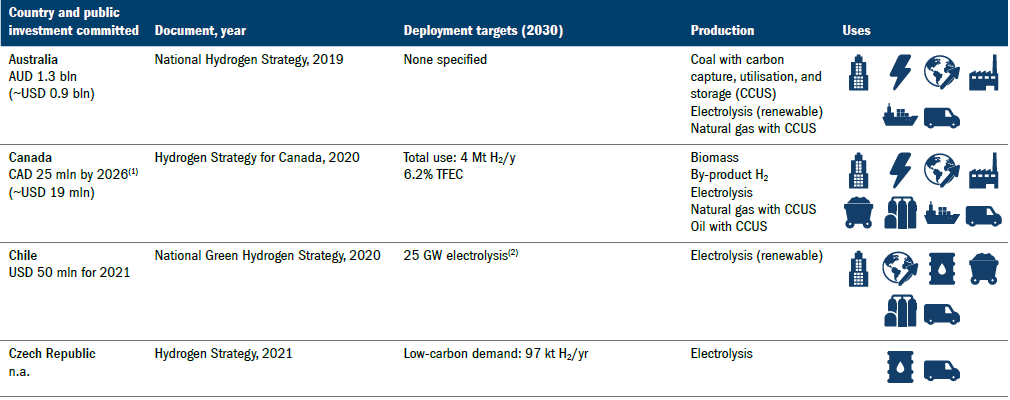


Source: IEA (October 2021).
Figure 2: Company and analyst transcript mentions
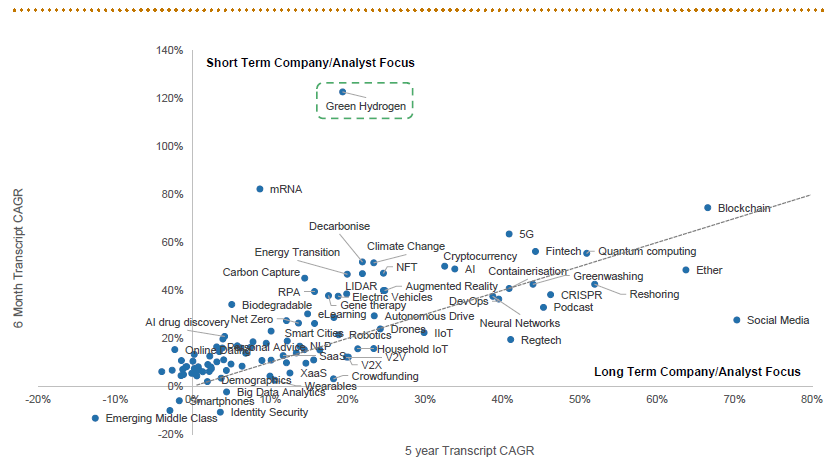
Source: MS Sept 2021.
What has changed in the past 12 months?
While discussion around green hydrogen
has seen steady growth, there have been
disproportionate levels of debate over
the past six and 12 months (Figure 2),
far exceeding any other topic including
5G, Blockchain and AI.4 So why the surge
of interest?
First and foremost, there is continuing
momentum in a number of factors that
have been key catalysts for increased
uptake over the past decade. Regarding
efficiency and costs, 2021 projections
suggest reductions in the hydrogen cost
curve, while manufacturing scale should
support a rapid pick up in adoption from
2030 onwards in many different industries
ranging from chemicals to trucking fuel
cells.5 A recently revised forecast by
Bloomberg puts green hydrogen costs
13% lower than previously suggested
by 2030.6 With prices of carbon at high
rates globally, and at recent all-time highs
within the EU,7 hydrogen’s potential as a
significant decarbonisation solution has
never had as much commercial viability.
The emergence of multiple exciting
hydrogen projects over the past 12
months have been influential in these
reduced estimates of cost and efficiency
improvements. Between December 2020
and August 2021 alone, the number of
green hydrogen projects increased more
than three-fold,8 with 359 large-scale
projects announced globally. Europe is
leading the way with investments of
$130 billion, but other regions are
catching up. China is also emerging as a potential hydrogen giant with
more than 50 projects in the pipeline
following its announcement of net-zero
emissions by 2060.9
A major cost development came to
light in the Q3 2021 report of NEL, the
world’s largest electrolyser producer.
It had been widely expected that the
cost of green hydrogen would be less
than $2/kg by 2030.10 But costs are
falling rapidly and NEL now has a green
hydrogen cost target of $1.50/kg by 2025.
This illustrates the pace of innovation
within green hydrogen and continued
decline in the cost of renewables globally.
Arguably the most influential element
in the progress of green hydrogen
production as a sustainability disruptor
is government support. Simply put,
governments across the world need a
plan for life after fossil fuels, and their
ability to create policies and regulations
to support green hydrogen both financially
and in terms of infrastructure could
prove vital in its viability. It is one thing
producing green hydrogen at a cost of
$1.50/kg, but for uptake to be aligned with
net-zero targets it needs to be delivered
to the end customer at a price that is
competitive with fossil fuels. Infrastructure
is needed to facilitate this process.
In the past year, the Chinese government
has made $20 billion of public funding
available for hydrogen projects. So far,
50% of its announced projects are linked
to transport applications, a key sector in
its energy transition plan.11 Meanwhile, the
US has renewed its net-zero commitment
by re-entering the Paris Agreement
following President Biden’s inauguration.12
In August 2021, the UK government
set its sights on developing a thriving
green carbon sector to overcome the
decarbonisation challenges facing its
economy, in the form of the UK Hydrogen
Strategy. Its ambition is to build 5GW of
low carbon hydrogen production capacity
by 2030. This could produce hydrogen
equivalent to the amount of gas consumed
by more than three million households in the UK each year.13 The UK Hydrogen
Strategy is all encompassing and takes
a holistic approach to developing a
thriving hydrogen sector. It sets out
what needs to happen to enable the
production, distribution, storage and use
of hydrogen, and to secure economic
opportunities across the UK.14
Figure 3: Private equity, infrastructure and hydrogen
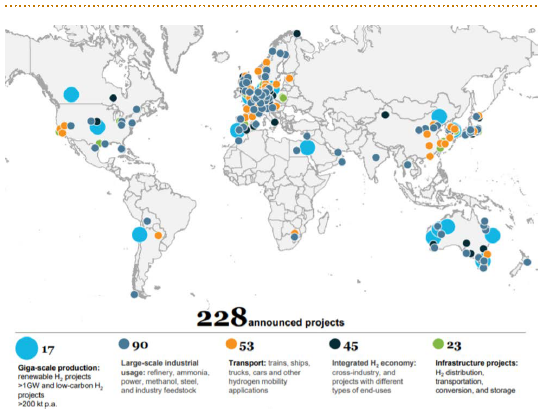
Source: Morgan Stanley – The Hydrogen Handbook. The Hydrogen Council.
Figure 4: Identifying infrastructure investments across the hydrogen value chain
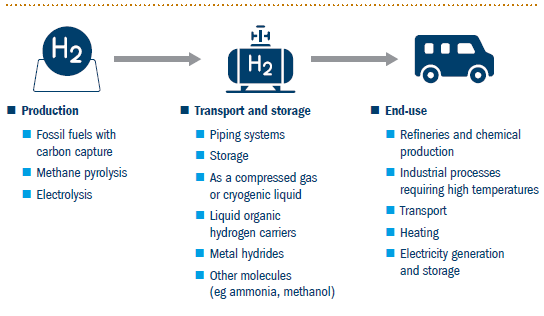
Source: Arup Hydrogen.
We are beginning to see an emergence of companies specialising in the production,
distribution and usage of Hydrogen.
Globally there are 228 ongoing hydrogen
projects across the value chain (Figure 3),
17 of which are giga-scale production
schemes. Two notable recent acquisitions are of the Canadian electrolyser company
Hydrogenics for $290 million15 by
power firm Cummins, and MAN Energy
Solutions’ majority share in Germanbased
electrolyser manufacturer H-TEC
Systems for an undisclosed fee.16
Interestingly, we are also seeing investment in riskier early-stage hydrogen
start-ups focused on the non-electrolysis
production of hydrogen. The funding
of such project development and
integration services could be indicative
of a maturing sector.17 The Hydrogen
Council estimates total investment in
the hydrogen value chain could exceed $300 billion by 2030 and, according
to the Energy Transitions Commission,
reach approximately $15 trillion by
2050.18 This demonstrates both the
requirement of, and opportunity for, private
investment within the chain (Figure 4).
While there are multiple barriers for the
uptake of hydrogen within the mainstream
– from cost to efficiency – we believe there
are two main ones. The first is current
limited demand. While from a production
perspective policy support is expanding,
technology is improving and cost is going
down, there is still a limited actual demand
for the molecule. Net-zero pledges could
however bolster demand (Figure 5). Further
infrastructure development will be a critical
determinant as to whether green hydrogen
becomes the panacea of decarbonisation.
Second is the underappreciation of
hydrogen within society. There has been a
stigma surrounding its use as a fuel ever
since the Hindenberg disaster in 1937.
Consumers and investors must be made
aware of the promise and safety of hydrogen
before it enters the mainstream. We believe
asset managers are becoming increasingly
aware of its potential and are attempting
to educate their investors. We hope the
public can be educated in much the same
way. We believe there is a huge opportunity
for the infrastructure sector in all of this:
without infrastructure projects, there will be
no mainstream consumption of hydrogen.
Figure 5: Hydrogen demand in the IEA’s Announced Pledges and Net-Zero Emissions scenarios
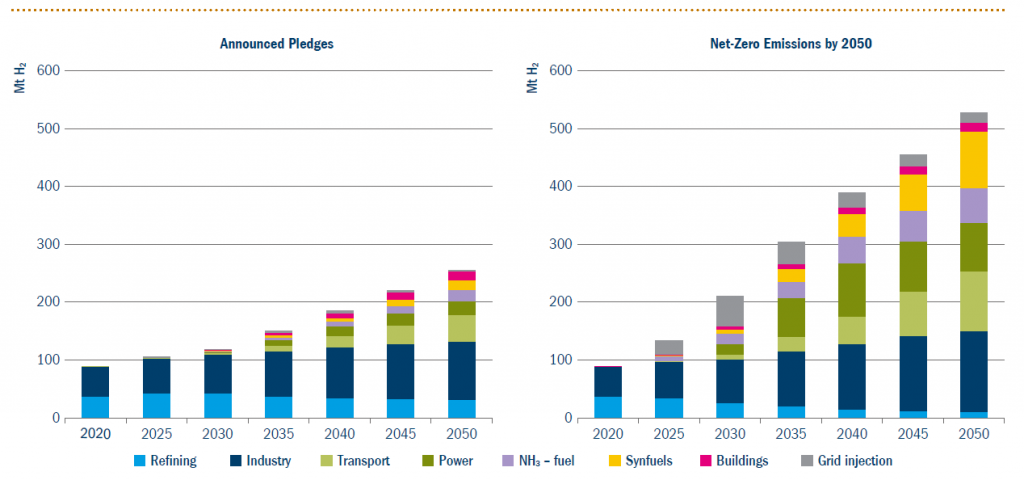
Source: IEA: 2021 Hydrogen Review.
Conclusion
The opportunity for green hydrogen to
disrupt the sustainable energy industry
cannot be denied – from increasing
technological improvements to scalability
and policy support, the past 12 months
have witnessed huge advancements
– and the pace at which it could do so
must not be underestimated. On a walk
down New York’s Fifth Avenue in 1900
you would likely have seen 1,000 horses
and one automobile. Just a decade or
so later it’s likely the opposite was the
case. In 1900 the car was inefficient,
unreliable and expensive versus the horse, but the long-term opportunity
was salient. Perhaps a decade from
now we will be questioning why there
was ever a debate about hydrogen.
Lack of demand is currently the main
barrier for the mainstream consumption
of hydrogen. While policy support is
growing exponentially, it is not close to
the level needed to achieve net-zero
energy system emissions by 2050.
A mixture of such support, through
incentivisation mechanisms for the
utilisation of hydrogen and development
of infrastructure, will be vital. Signs of growing investment in the latter are
positive. However, to retain this momentum
policy will need to focus not just on
reducing costs but on creating supporting
infrastructure to ensure demand. Policy
support is strong, as illustrated in Figure 1,
but there is scope for more, especially
as countries outline their net-zero
goals. The recent rise in energy prices
may fast-track policies in the next 12
months. Post-COP26 we should have
better insights around policy support,
and we may be able to identify prominent,
fruitful infrastructure opportunities.





